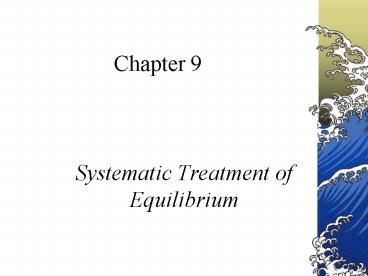Systematic Treatment of Equilibrium - PowerPoint PPT Presentation
1 / 20
Title:
Systematic Treatment of Equilibrium
Description:
Applications of Chemistry in other Sciences. Equilibrium ... Negated this idea in Chapter 8. Water Sheath. Ions other than just the desired exist in solution ... – PowerPoint PPT presentation
Number of Views:761
Avg rating:3.0/5.0
Title: Systematic Treatment of Equilibrium
1
Chapter 9
- Systematic Treatment of Equilibrium
2
Chemical Equilibrium
- Basis For
- Titrations
- Chromatography
- Applications of Chemistry in other Sciences
3
Equilibrium Assumptions
- Ion is Naked
- Negated this idea in Chapter 8
- Water Sheath
- Ions other than just the desired exist in
solution - Reaction of interest is the only one in solution
- Realistic?
4
Equilibrium Assumptions
- Examples
- Destruction of limestone and marble in buildings
- CaCO3(s) ? Ca2 CO32-
- CO32- H2O ? HCO3- OH-
- HCO3- H2O ? H2CO3 OH-
- or
- Formation of acid rain
- SO2 H2O ? H2SO3
- H2SO3 oxidation ? H2SO4
5
Equilibrium Calculations
- Previous
- BaC2O4 ? Ba2 C2O42-
- Ba2 C2O42-
- But what if oxalate then reacted with H2O
- C2O42- H2O ? HC2O4- OH-
- HC2O4- H2O ? H2C2O4 OH-
- Ba2 ? C2O42-
- because C2O42- C2O42- HC2O4- H2C2O4
6
Systematic Treatment of Equilibrium
- Step 1. Write all pertinent reactions
- Step 2. Write the charge balance equation
- Step 3. Write the mass balance equation
- Step 4. Write the equilibrium constant for each
chemical reaction (should use activities but we
will ignore them) - Step 5. Count the equations and unknowns (
equations unknowns) - Step 6. Solve the unknowns
7
Charge Balance Equations
- Charge Balance Equations -
- An algebraic statement of electroneutrality.
- The concentration of the sum of the positive
charges the concentration of the sum of the
negative charges. - General Form of the Equation
- n1C1 n2C2 m1A1 m2A2
- n1 and m1 represent the magnitude of the charge
of the ion - C1 and A1 represent the concentration of each
cation and anion respectively
8
Charge Balance Examples
- Given
- H 5.1 x 10-12 M K 0.0550 M
- OH- 0.0020 M H2PO4- 1.3 x 10-6 M
- HPO42- 0.0220 M PO43- 0.0030 M
- Find the solution for the Charge Balance
equation.
9
Charge Balance Examples
- Write the charge balance equation for a solution
containing H2O, H, OH-, ClO4-, Fe(CN)63-,
CN-, Fe3, Mg2, CH3OH, HCN, NH3, and NH4.
10
Charge Balance Examples
- Write a charge balance equation for aqueous
solution of glycine, which reacts as follows - H3NCH2CO2- ? H2NCH2CO2- H
- H3NCH2CO2- H2O ? H3NCH2CO2H OH-
11
Charge Balance Examples
- Write a charge balance equation for a solution of
Al(OH)3 dissolved in 1 M KOH. Possible species
are Al3, AlOH2, Al(OH)3, Al(OH)2, and Al(OH)4-
12
Mass Balance Equation
- Mass Balance (Material Balance) -
- Statement of Conservation of Matter - The
quantity of all species in a solution containing
a particular atom (or group of atoms) must be
equal to the amount of that atom (or group of
atoms) delivered to the solution.
13
Mass Balance Example (known concentrations)
- Write the mass balance equation for the acetate
group of atoms in a 0.05 M solution of acetic
acid. - Write the mass balance equation for the phosphate
group of atoms in a 0.025 M solution of
phosphoric acid.
14
Mass Balance Example (known concentrations)
- Write the mass balances for K and for phosphate
in a solution prepared by mixing 0.0250 mol
KH2PO4 plus 0.0300 mol KOH and diluting to 1.0 L. - Write a mass balance equation for a 0.05 M
solution of glycine in water.
15
Mass Balance Example (known concentrations)
- Suppose that 0.30 g of AlOOH (FM 59.99) plus
150 mL of 3.0 M KOH are diluted to 1.0 L to give
the species Al3, AlOH2, Al(OH)3, Al(OH)2, and
Al(OH)4-
16
Mass Balance Example (unknown concentrations)
- Write the mass balance equation for La(IO3)3.
- Write the mass balance equation for a saturated
solution of slightly soluble Ag3PO4, which
produces PO43- and 3Ag when it dissolves.
17
Systematic Treatment of Equilibrium
- Determining the equations used to calculate
unknown concentrations is the heart of this type
of problem - The hard part, however, is solving for multiple
unknowns using these equations
18
Systematic Treatment of Equilibrium
- Calculate the concentration of the hydronium and
hydroxide ions in water. - Calculate the concentration of Hg22 in a
saturated solution of Hg2Cl2. - Find the solubility of CaF2 in water if the pH is
somehow fixed at 3.0.
19
Systematic Treatment of Equilibrium
- Find the solubility of Ba(C2O4) in water assuming
a pH of 2.0. Calculate the concentration of all
species in solution.
20
Chapter 9 - Homework
- Problems 2, 4, 8, 9, 18, 22, 23































